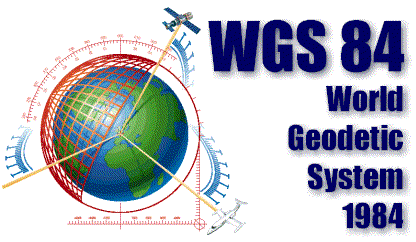
Is definition of WGS 84 correct?
Is Definition of WGS84 Correct?
by
MUNEENDRA
KUMAR, PHD AND JAMES P REILLY, PHD
A Geodetic Analysis
The first and original version of the "WGS 84", defined by a special committee of the Defense Mapping Agency (DMA), was released in September 1987.As this task of updating the WGS 72 was concurrent with development of the North
American Datum (NAD) 1983, the committee members always had many in-depth
discussions with the members of the special committee of the National Geodetic
Survey (NGS). This approach ensured the; correct geodetic definition both for
WGS 84 and NAD 83. Around 1992, it was decided by DMA that, in future update(s)
of the "WGS 84" for accuracy enhancement, the academia and other satellite
geodesy experts would be associated. However, that scientific participation was
not followed and three subsequent updates were carried out without in-depth
discussions of satellite geodetic theory and/or correct statistical evaluation.
The non-scientific procedure(s) allowed definition deficiencies to creep in.
This paper outlines the geodetic details of the three updated versions of 1994,
1996, and 2001 and brings out in "open" the definition deficiencies in the
current version WGS 84 (G1150), which otherwise will remain hidden within the
National Geospatial- Intelligence Agency (NGA).The correctly defined "WGS 84",
the coordinate system used in GPS, is a critical requirement for the geodetic
integrity and accurate GPS positioning.
1984 "Original" Definition
The WGS 84 was originally defined with BIH Conventional Terrestrial System (CTS) for Reference Epoch "RE (84.0)". The main satellite data sets used were from the
Navy Navigation satellite System (NNSS). At the time of release in 1987, the
accuracy achieved was in the order of ± 1 - 2 meter and as such the tidal
effects, as specified in the International Association of Geodesy (IAG)
Resolution 16 of 1983 were not considered.
The "Three" WGS 84 Updates1994 "WGS 84 (G730)"
This version was updated with the International Earth Rotation Service(IERS) realized International Terrestrial Reference Frame (ITRF) 19921, RE (88.0). During this update, NGA moved the RE (88.0) of the defining
ITRF to RE (94.0), which is incorrect. For this "change", DMA geodesists did not
have the capability and expertise. And, they did not have the authority to
override IERS. Note: With a new origin and orientation of its three axes, WGS 84
(G730) is geodetically a different coordinate system than the original WGS 84.
For mapping, the two could be considered the same. 1 First six ITRF solutions,
viz., ITRF 1988, ITRF 1989, ITRF 1990, ITRF 1991, ITRF 1992, and ITRF 1993, were realized for the RE (88.0). As the ITRF 1993 was based on all the data sets
available up to the end of year 1993 and thus realized in 1994, it would not
have been possible for DMA to define the WGS 84 (G730), which was realized using
the GPS data for the week starting 2 January 1994.
1996 "WGS 84 (G873)"At the time of this update, the ITRF 1994, RE (93.0) was used (Note: ITRF96 (93.0) was not available). But, DMA geodesists again incorrectly moved the epoch of the
defining "RF" to RE (97.0). And, for geodetic application, they created the
third WGS 84. In addition, ignoring IAG Resolution No. 16 of 1983 and bypassing
IERS Conventions (IERS, 96), which recommend the "Zero-tide" model, National
Imagery and Mapping Agency (NIMA) geodesists adopted an "arbitrary" practice to
use "Tide-free" model. Note: According to IERS, the positions in the "Tide-free"
environ are non-realistic and not observable.
2001 Current "WGS 84 (G1150)"
During the updating of this version, the ITRF00, RE (97.0) was used.
But, like the 1994 and 1996 versions, NIMA geodesists incorrectly moved the RE
of the defining RF from (97.0) to (01.0), They also kept the 1996 practice for
"Tide-free" model, even after being alerted that the world's eminent geodesists
support the "Zerotide" of the IAG' standing Resolution No. 16 of 1983.
Furthermore, during the adjustment of the GPS tracking stations network, about
65% stations were held fixed (Note: An objection by the first author was not
even discussed). This over constrained adjustment is statistically incorrect and
not acceptable. Note: For geodetic positioning, this is the fourth version of
WGS 84.
The "Version" Identifiers
The "G730", "G873", and "G1150" indicate the GPS-week, of which the data sets were used to realize the three updates. As these "identifiers" do NOT specifically identify any definite time epoch, they do NOT have any geodetic significance.Important "Contrast" To Note In SIRGAS 2000, the "RE" of the defining ITRF has NOT been "moved".
Analytical Conclusion
The current "WGS 84 (G1150)" is incorrectly defined, does not
comply with IAG Resolution No. 16 of 1983, and its time epoch is not definitive.
Furthermore, the adjustment of the GPS tracking station network is statistically
incorrect.
Reference
IERS, 96 IERS Conventions, Tech Note 21, July 1996.
